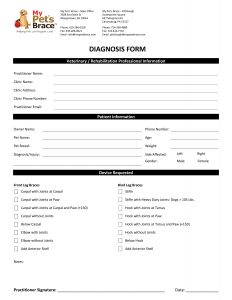 By: Terry Lackmeyer, My Pet’s Brace Customer Service Representative
By: Terry Lackmeyer, My Pet’s Brace Customer Service Representative
“Thank you for calling My Pet’s Brace. How can I help you?”
“My dog is limping on his hind leg and needs a brace,” replies the caller.
“Sure, I can help you with that. What is your dog’s injury? What is the diagnosis from your vet?”
“Oh, I didn’t take him to the vet. He’s just limping so I want a brace. Can you make one for him?”
“Sure, we can make a brace but in order the make the correct type of brace we need to know what your dog’s injury is. The dog must see the vet so that we know what is causing the limp.”
“Oh, he’s had this limp for a while. It gets better then it gets worse. I had another dog that had a cruciate ligament injury, and he’s acting the same way. I see no reason to take him to the vet because I’m pretty sure it’s the same thing.”
Unfortunately, the above conversation happens all too often. While we can guess from the conversation and our experience that this dog probably has a torn cruciate ligament in his knee, we cannot nor should we make that assumption. Although our owner is a board-certified prosthetist orthotist which means he has lots of medical knowledge and experience, and our clinicians have bio-medical engineering backgrounds, they are not veterinarians and legally cannot make a diagnosis.
There could be many problems causing this dog to limp and some may not even originate in the knee. For example, the dog may have a problem in his hock for which we could make a brace, but it is an entirely different type of brace than one we would make for a problem in the knee. Maybe the dog has a problem in his hip, such as hip dysplasia, for which we have no type of brace. The dog may have some type of neurological problem for which braces usually do not help. As you can see, getting the correct diagnosis is very important.
Veterinarians go to school for many years to learn how to evaluate and differentiate among the countless problems that they see in pets daily. Whether we are talking about your pet’s front or back legs, knees, hocks, carpals, or elbows, getting the correct diagnosis is imperative and required for us to make the most appropriate brace for your pet. Sometimes, in conjunction with the diagnosis, we also need x-rays and, if that is necessary, we would let you know. For example, if we are seeing a dog for a prosthetic device or fracture, x-rays may be helpful.
We are here to provide your pet with the best solution for their orthopedic problem and to do that we need to have the proper diagnosis, in writing, from your vet.
